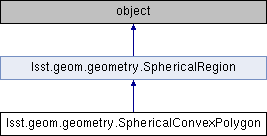
Public Member Functions | |
| def | __init__ (self, args) |
| def | getVertices (self) |
| def | getEdges (self) |
| def | getBoundingCircle (self) |
| def | getBoundingBox (self) |
| def | getZRange (self) |
| def | clip (self, plane) |
| def | intersect (self, poly) |
| def | area (self) |
| def | containsPoint (self, v) |
| def | contains (self, pointOrRegion) |
| def | intersects (self, pointOrRegion) |
| def | __repr__ (self) |
| def | __eq__ (self, other) |
| def | __hash__ (self) |
Public Attributes | |
| boundingBox | |
| boundingCircle | |
| vertices | |
| edges | |
Detailed Description
A convex polygon on the unit sphere with great circle edges. Points falling exactly on polygon edges are considered to be inside (contained by) the polygon.
Definition at line 1110 of file geometry.py.
Constructor & Destructor Documentation
◆ __init__()
| def lsst.geom.geometry.SphericalConvexPolygon.__init__ | ( | self, | |
| args | |||
| ) |
Creates a new polygon. Arguments must be either: 1. a SphericalConvexPolygon 2. a list of vertices 3. a list of vertices and a list of corresponding edges In the first case, a copy is constructed. In the second case, the argument must be a sequence of 3 element tuples/lists (unit cartesian 3-vectors) - a copy of the vertices is stored and polygon edges are computed. In the last case, copies of the input vertex and edge lists are stored. Vertices must be hemispherical and in counter-clockwise order when viewed from outside the unit sphere in a right handed coordinate system. They must also form a convex polygon. When edges are specified, the i-th edge must correspond to the plane equation of great circle connecting vertices (i - 1, i), that is, the edge should be a unit cartesian 3-vector parallel to v[i-1] ^ v[i] (where ^ denotes the vector cross product). Note that these conditions are NOT verified for performance reasons. Operations on SphericalConvexPolygon objects constructed with inputs not satisfying these conditions are undefined. Use the convex() function to check for convexity and ordering of the vertices. Or, use the convexHull() function to create a SphericalConvexPolygon from an arbitrary list of hemispherical input vertices.
Definition at line 1116 of file geometry.py.
Member Function Documentation
◆ __eq__()
| def lsst.geom.geometry.SphericalConvexPolygon.__eq__ | ( | self, | |
| other | |||
| ) |
Definition at line 1456 of file geometry.py.
◆ __hash__()
| def lsst.geom.geometry.SphericalConvexPolygon.__hash__ | ( | self | ) |
Definition at line 1476 of file geometry.py.
◆ __repr__()
| def lsst.geom.geometry.SphericalConvexPolygon.__repr__ | ( | self | ) |
Returns a string representation of this polygon.
Definition at line 1450 of file geometry.py.
◆ area()
| def lsst.geom.geometry.SphericalConvexPolygon.area | ( | self | ) |
◆ clip()
| def lsst.geom.geometry.SphericalConvexPolygon.clip | ( | self, | |
| plane | |||
| ) |
Returns the polygon corresponding to the intersection of this polygon with the positive half space defined by the given plane. The plane must be specified with a cartesian unit vector (its normal) and always passes through the origin. Clipping is performed using the Sutherland-Hodgman algorithm, adapted for spherical polygons.
Definition at line 1220 of file geometry.py.
◆ contains()
| def lsst.geom.geometry.SphericalConvexPolygon.contains | ( | self, | |
| pointOrRegion | |||
| ) |
Returns True if the specified point or spherical region is completely contained in this polygon. Note that the implementation is conservative where ellipses are concerned: False may be returned for an ellipse that is actually completely contained by this polygon.
Definition at line 1333 of file geometry.py.
◆ containsPoint()
| def lsst.geom.geometry.SphericalConvexPolygon.containsPoint | ( | self, | |
| v | |||
| ) |
Definition at line 1327 of file geometry.py.
◆ getBoundingBox()
| def lsst.geom.geometry.SphericalConvexPolygon.getBoundingBox | ( | self | ) |
Returns a bounding box for this spherical convex polygon.
Definition at line 1202 of file geometry.py.
◆ getBoundingCircle()
| def lsst.geom.geometry.SphericalConvexPolygon.getBoundingCircle | ( | self | ) |
Returns a bounding circle (not necessarily minimal) for this spherical convex polygon.
Definition at line 1190 of file geometry.py.
◆ getEdges()
| def lsst.geom.geometry.SphericalConvexPolygon.getEdges | ( | self | ) |
Returns the list of polygon edges. The i-th edge is the plane equation for the great circle edge formed by vertices i-1 and i.
Definition at line 1184 of file geometry.py.
◆ getVertices()
| def lsst.geom.geometry.SphericalConvexPolygon.getVertices | ( | self | ) |
Returns the list of polygon vertices.
Definition at line 1179 of file geometry.py.
◆ getZRange()
| def lsst.geom.geometry.SphericalConvexPolygon.getZRange | ( | self | ) |
Returns the z coordinate range spanned by this spherical convex polygon.
Definition at line 1212 of file geometry.py.
◆ intersect()
| def lsst.geom.geometry.SphericalConvexPolygon.intersect | ( | self, | |
| poly | |||
| ) |
Returns the intersection of poly with this polygon, or None if the intersection does not exist.
Definition at line 1301 of file geometry.py.
◆ intersects()
| def lsst.geom.geometry.SphericalConvexPolygon.intersects | ( | self, | |
| pointOrRegion | |||
| ) |
Returns True if the given point or spherical region intersects this polygon. Note that the implementation is conservative where ellipses are concerned: True may be returned for an ellipse that is actually disjoint from this polygon.
Definition at line 1406 of file geometry.py.
Member Data Documentation
◆ boundingBox
| lsst.geom.geometry.SphericalConvexPolygon.boundingBox |
Definition at line 1145 of file geometry.py.
◆ boundingCircle
| lsst.geom.geometry.SphericalConvexPolygon.boundingCircle |
Definition at line 1146 of file geometry.py.
◆ edges
| lsst.geom.geometry.SphericalConvexPolygon.edges |
Definition at line 1152 of file geometry.py.
◆ vertices
| lsst.geom.geometry.SphericalConvexPolygon.vertices |
Definition at line 1151 of file geometry.py.
The documentation for this class was generated from the following file:
- /home/jenkins-slave/snowflake/release/lsstsw/stack/Linux64/geom/15.0+10/python/lsst/geom/geometry.py
 1.8.13
1.8.13